Discover 15 hidden attractions, cool sights, and unusual things to do in Fort Smith (United States). Don't miss out on these must-see attractions: Fort Smith National Historic Site, Fort Smith Trolley Museum, and W.H.H. Clayton House. Also, be sure to include Fort Smith Museum of History in your itinerary.
Below, you can find the list of the most amazing places you should visit in Fort Smith (Arkansas).
Table of Contents
Fort Smith National Historic Site

Historical place in Fort Smith, Arkansas. Fort Smith National Historic Site is a National Historic Site located in Fort Smith, Arkansas, along the Arkansas River. The first fort at this site was established by the United States in 1817, before this area was established as part of Indian Territory. It was later replaced and the second fort was operated by the US until 1871. This site was designated as a National Historic Landmark in 1961.
The fort was the first site of the United States District Court for the Western District of Arkansas, which had jurisdiction over western Arkansas and all of Indian Territory. It began operations in 1875 with the appointment of Isaac C. Parker as the first federal district judge here. The town of Fort Smith, Arkansas developed around the fort.[1]
Address: 301 Parker Ave, 72901-1938 Fort Smith
Fort Smith Trolley Museum
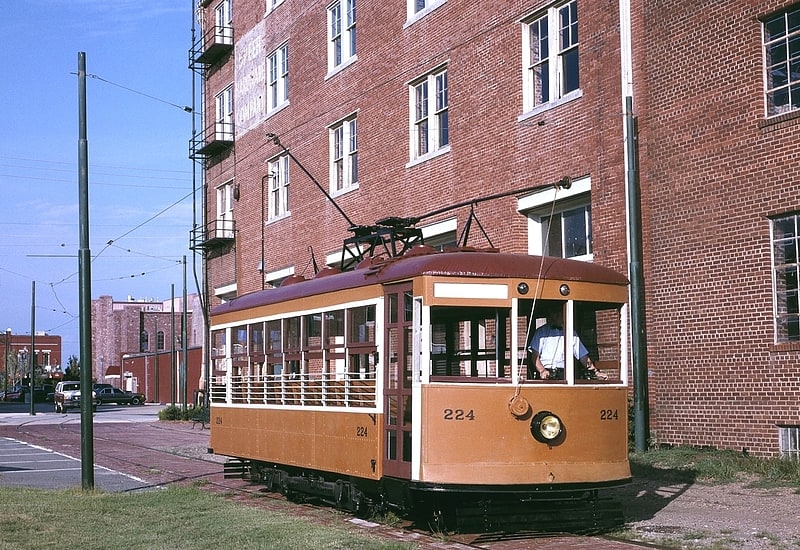
Museum in Fort Smith, Arkansas. The Fort Smith Trolley Museum is a streetcar and railroad museum in Fort Smith, in the U.S. state of Arkansas, which includes an operating heritage streetcar line. The museum opened in 1985, and operation of its streetcar line began in 1991. Four vehicles in its collection, a streetcar and three steam locomotives, are listed on the National Register of Historic Places. The now approximately three-quarters-mile-long streetcar line also passes four NRHP-listed sites, including the Fort Smith National Historic Site, the Fort Smith National Cemetery, the West Garrison Avenue Historic District and the 1907 Atkinson-Williams Warehouse Building, which now houses the Fort Smith Museum of History.[2]
Address: 100 S 4th St, 72901-1947 Fort Smith
W.H.H. Clayton House
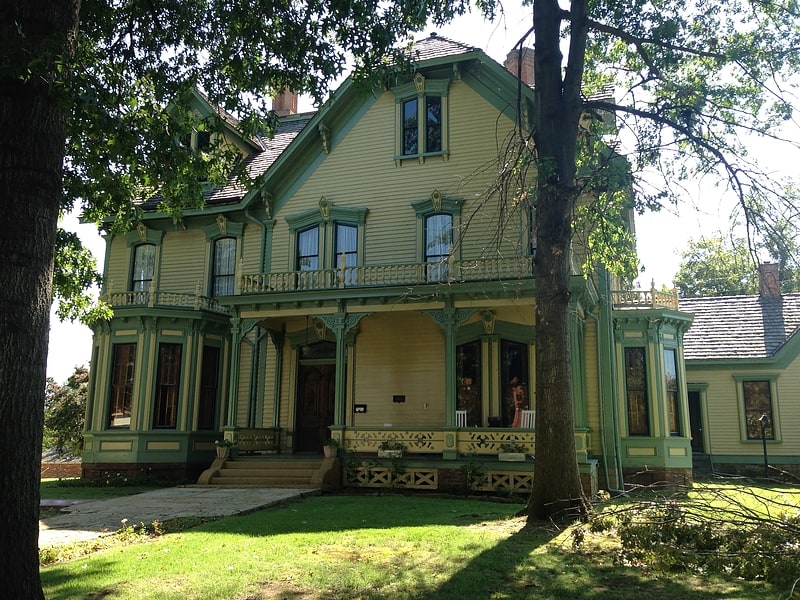
Museum in Fort Smith, Arkansas. The W.H.H. Clayton House, now the Clayton House Museum, is a historic house museum at 514 North 6th Street in Fort Smith, Arkansas. It is a 2+1⁄2-story L-shaped wood-frame structure, with a projecting front clipped-gable section. It has elaborate Victorian trim, including detailed window surrounds, paneled projecting bays on the front and side, and a porch with carved columns and brackets, and delicately turned balusters ringing the porch roof. The house was built in 1882 for W. H. H. Clayton, who served as a local prosecutor and was member of family prominent in state politics, and is one of the few high-quality houses of the period to survive. It is now a museum.
The house was the home of W.H.H. Clayton, United States Attorney for the United States District Court for the Western District of Arkansas and chief prosecutor in the court of "hanging judge" Isaac Parker.
The house was listed on the National Register of Historic Places in 1970.[3]
Address: 514 N 6th St, 72901-2006 Fort Smith
Fort Smith Museum of History
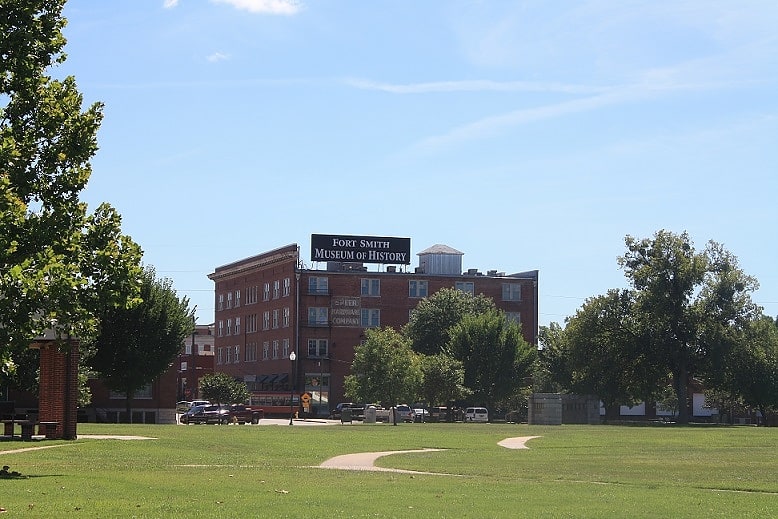
Museum in Fort Smith, Arkansas. The Fort Smith Museum of History is located at 320 Rogers Avenue in Fort Smith, Arkansas. The museum is devoted to presenting the history of Fort Smith and the surrounding region. It is located near the Fort Smith National Historic Site in the former Atkinson-Williams Warehouse, built in 1906 and one of the city's oldest surviving commercial warehouse buildings. The building, a large four-story brick building with typical early-20th-century commercial styling, was listed on the National Register of Historic Places in 1979.[4]
Address: 320 Rogers Ave, 72901-1937 Fort Smith
Belle Grove Historic District

Belle Grove Historic District is a predominantly residential historic district north of the central business district of Fort Smith, Arkansas. This area became an affluent residential area not long after Fort Smith was established in 1842, and was most heavily developed between about 1870 and 1930. It is one of the oldest residential neighborhoods in the state. It includes a cross-section of architectural styles popular in the late 19th and early 20th centuries, although its oldest building, the c. 1840 John Rogers House, is Greek Revival in style. The district is roughly bounded by North 4th, North 9th, North "B", and North "H" Streets.
The district was listed on the National Register of Historic Places in 1973.[5]
Sebastian County Courthouse-Ft. Smith City Hall
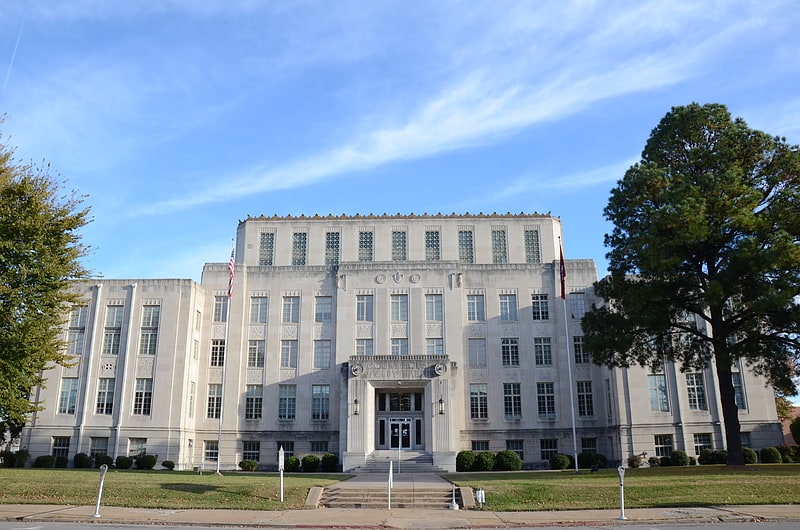
Building in Fort Smith, Arkansas. The Sebastian County Courthouse/Fort Smith City Hall is a historic civic building at 100 South 6th Street in Fort Smith, Arkansas. It is a large four-story stone and concrete structure with modest Art Deco styling, designed by Fort Smith architects E. Chester Nelson, T. E. Bassham, and Carnall Wheeler and built in 1937 with funding from the Public Works Administration. Its interior lobby and courthouse spaces are richly decorated, with marble walls, terrazzo marble flooring, and ornamental moldings around doorways. The building continues to house county facilities; the city offices are now located on Garrison Avenue.
The building was listed on the National Register of Historic Places in 1993.[6]
Fort Smith National Cemetery
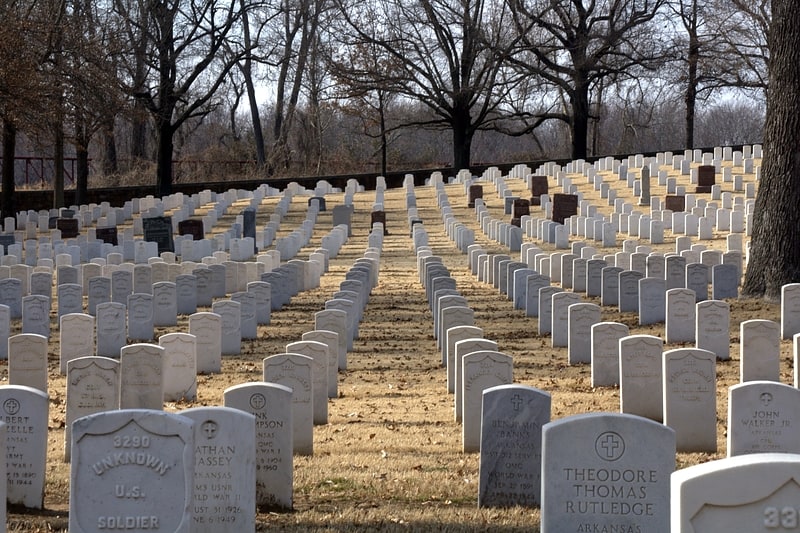
Cemetery. Fort Smith National Cemetery is a United States National Cemetery located at Garland Avenue and Sixth Street in Fort Smith, Sebastian County, Arkansas. It encompasses 22.3 acres, and as of the end of 2005, had 13,127 interments.[7]
Address: 522 Garland Avenue and South 6th Street, 72901 Fort Smith
Christ the King Church
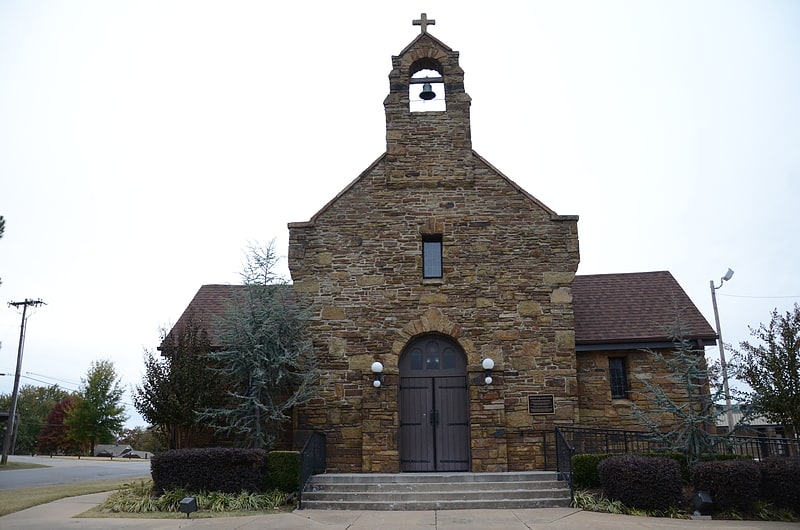
Church building in Fort Smith, Arkansas. The Christ the King Church is a historic church building at Greenwood and South "S" Streets in Fort Smith, Arkansas. It is a Mission/Spanish revival style church built out of native fieldstone in 1930 to a design by Thompson, Sanders & Ginocchio. It is an architecturally distinctive example of the work of Arkansas architect Charles L. Thompson, with transepts located near the front of the building, and the angled parapet leading to the open belltower. The building is now used by the parish as an academic facilities.
The building was listed on the National Register of Historic Places in 1982.[8]
Address: 1920 S Greenwood Ave, 72901-5899 Fort Smith (Fort Smith Southside)
Ft. Smith Confederate Monument

Monument in Fort Smith, Arkansas. The Ft. Smith Confederate Monument stands on the grounds of the Sebastian County Courthouse at the junction of 6th and Rogers Streets in Fort Smith, Arkansas. The statue depicts a Confederate Army soldier, standing facing north, holding the upper stock of his rifle, which is grounded. The sculpture is 6 feet in height, and is mounted on a square columnar pedestal over 30 feet tall. The monument was placed in 1903 with funding raised by the local chapter of the Daughters of the Confederacy. An earlier Confederate memorial, placed at Fort Smith National Cemetery, was destroyed by a tornado, and the federal government objected to the placement of this memorial there without alterations to also commemorate the Union dead. The city granted permission for its placement at its current location.
The monument was listed on the National Register of Historic Places in 1993.[9]
South Side Baptist Church
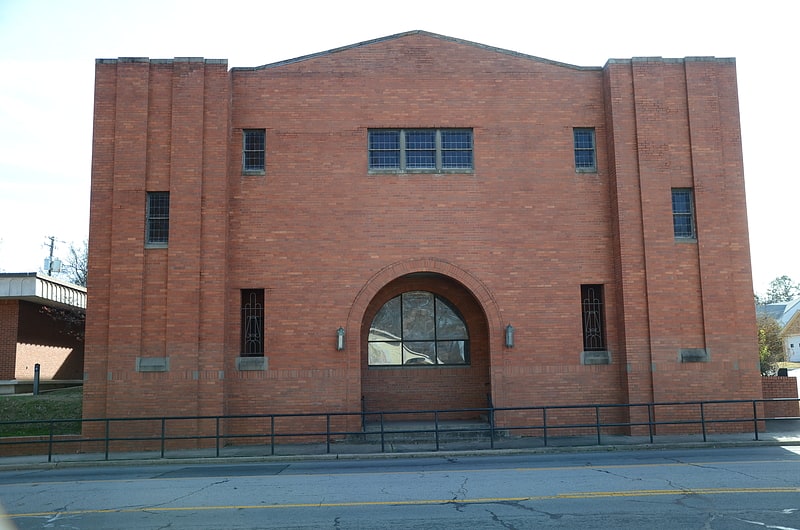
Baptist church in Fort Smith, Arkansas. South Side Baptist Church is a historic Southern Baptist church at 2400 Dodson Avenue in Fort Smith, Arkansas. It is a large two-story brick building, built in 1948 with Moderne styling. The main facade is symmetrically arranged, with its entrances recessed to the sides of a round Romanesque arch, whose rear wall presents a round-arch window. Narrow windows and projecting corner sections relieve the mass of brickwork, with the corner sections providing vertical emphasis with piers and rising the height of the building. The building is a rare local example of the Moderne style. It is used by the church for educational facilities.
The building was listed on the National Register of Historic Places in 2006.[10]
Address: 2400 Dodson Ave, 72901-4122 Fort Smith (Fort Smith Southside)
Janet Huckabee Arkansas River Valley Nature Center
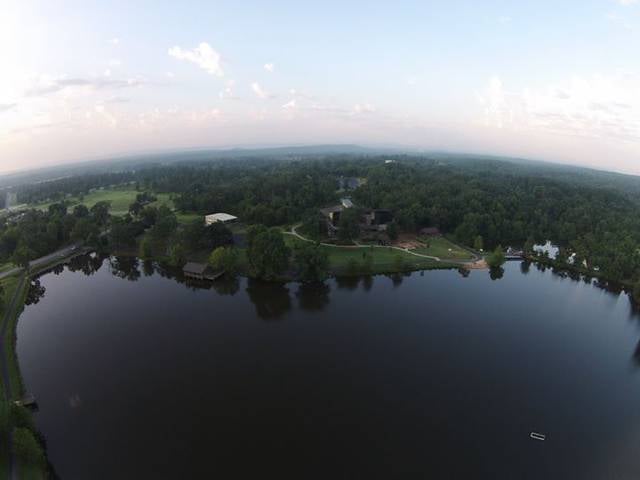
Nature, Outdoor activities, Natural attraction, Valley
Address: 8300 Wells Lake Rd, 72916-8849 Fort Smith
Dodson Avenue Methodist Episcopal Church
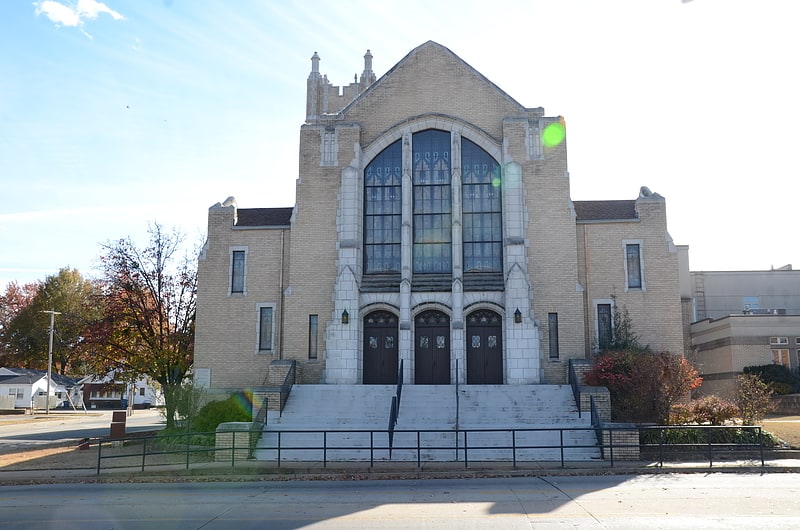
Building in Fort Smith. The Goddard United Methodist Church formerly the Dodson Avenue Methodist Episcopal Church, is a historic church at 1922 Dodson Avenue in Fort Smith, Arkansas. The church building is an imposing Late Gothic stone structure, built in 1930 to a design by the local architectural firm of Haralson and Nelson. The congregation for which it was built was founded in 1908, and worshipped in a wood-frame church at this site prior to the construction of the present edifice. In October 1945 the church was renamed the Goddard Memorial Methodist Church in honor of a recent pastor, Dr. O. E. Goddard. The church complex includes, in addition to the church, a children's building, fellowship hall, and office building.
The church was listed on the National Register of Historic Places in 2006.[11]
Saint Scholastica Convent
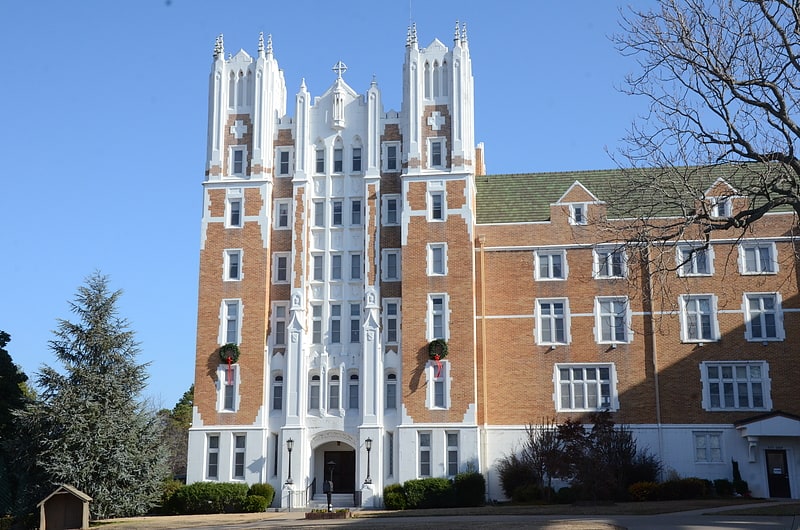
The Saint Scholastica Convent, now the Saint Scholastica Monastery, is a historic religious facility at 1301 South Albert Pike Avenue in Fort Smith, Arkansas. It is a large multi-winged brick and masonry complex with Late Gothic Revival architecture, five stories in height, set on a large landscaped property behind Trinity Junior High School. The building was designed by Oklahoma City architect F. W. Redlich, and was built in 1923–24. It originally housed living quarters for the convent as well as a chapel and school; the school closed in 1969, and the academic space is now leased to the Trinity School.
The property was listed on the National Register of Historic Places in 2006.[12]
Address: 1301 S Albert Pike Ave, 72903-2411 Fort Smith (Fort Smith Northside)
Echols Memorial Christian Church
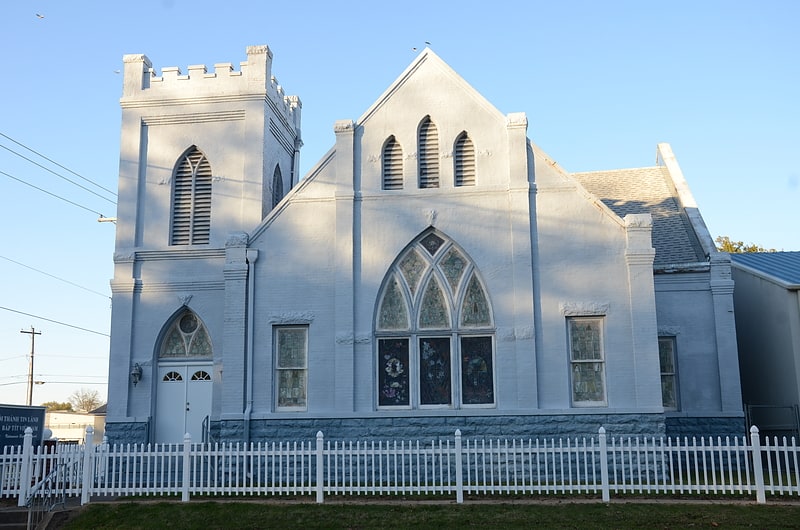
Christian church in Fort Smith. The Echols Memorial Christian Church, now home to the Vietnamese Baptist Church, is a historic church building at 2801 Alabama Avenue in Fort Smith, Arkansas. It is a large rectangular brick and stone structure, with a square tower at its southwest corner. Its roof has a cross gable configuration, with large Gothic stained-glass in the gable ends. The main entrance is set in the tower recessed in a Gothic-arched opening. Built in 1911 with funds donated by Mrs. Elizabeth Echols, it is an excellent local example of Late Gothic styling built using local materials.
The building was listed on the National Register of Historic Places in 2006.[13]
New Theatre
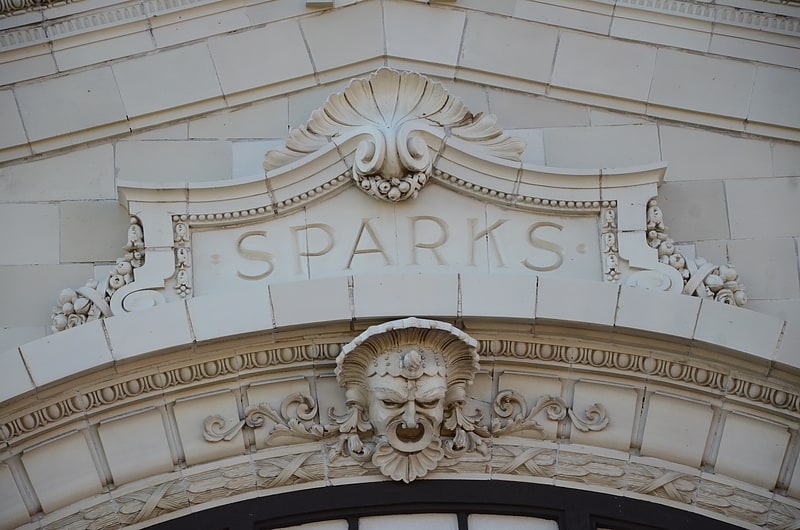
The New Theatre is a historic theatre building at 11 North 10th Street in Fort Smith, Arkansas. The Beaux Arts building was built in 1911, and was supposedly modeled on the New Amsterdam Theatre in New York City. The building's facade features a rich variety of decoration, including terra cotta glazed tile, terra cotta brick work, and elaborate border cartouches. The theatre began as a performing arts venue, but was converted to nearly exclusive use as a film house in the 1940s. It was closed in the 1970s, and restoration efforts have been taking place sporadically since the 1990s.
The building was listed on the National Register of Historic Places in 1999. It is vacant.[14]